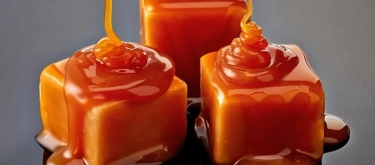Chewing gum: Taste Profile, Aroma, Benefits and Health Risks
Chewing gum is a confectionery designed for chewing rather than swallowing. Its roots go back to ancient civilizations, where tree resins and natural latex were chewed for refreshment. Modern chewing gum developed in the 19th century, particularly in the United States, and soon spread worldwide. Today, chewing gum is associated with breath-freshening, stress relief, and everyday habit, making it one of the most widely consumed confections.
Chewing gum typically contains gum base, sweeteners, softeners, flavorings, and colorants. Sugar-free versions often include sorbitol, xylitol, or aspartame, which may cause digestive discomfort if consumed in excess. Some products contain gelatin, shellac, or beeswax, making them unsuitable for vegans, kosher, or halal diets unless specifically certified. Not recommended for children under 3 due to choking risks.
What does Chewing gum taste like?

Complete Sensory Description
-
Taste: Chewing gum usually begins with a strong burst of flavor — often mint, cinnamon, or fruit — that fades gradually with time. Sugar-based gums leave a sweet aftertaste, while sugar-free gums may finish with a slightly bitter note from artificial sweeteners.
-
Aroma: Fresh and pleasant, with mint varieties releasing a cooling, mentholated scent that can be felt even before chewing. Fruity gums smell lighter and more candy-like, though the aroma fades more quickly.
-
Texture: Firm at the first bite, then softens into a smooth, elastic mass. It is less stretchy than bubble gum and not suitable for bubbles. Over time, the gum becomes bland and rubbery.
-
Appearance: Available as sticks, tablets, pellets, or coated dragees. Colors vary — most mint gums are white or pale green, while fruity varieties are more colorful. Packaging is compact and designed for portability.
In-depth Flavor Analysis
The sensory profile of chewing gum comes from flavor oils and sweeteners bound to the gum base. Mint flavors rely on menthol, carvone, and eucalyptol, which stimulate cooling receptors in the mouth. Cinnamon gums often contain cinnamaldehyde, which gives a warming effect. Fruit flavors are achieved using esters such as isoamyl acetate (banana) or ethyl butyrate (pineapple).
The gum base itself consists of synthetic elastomers and resins, providing chewability. Flavor release occurs as soluble compounds are extracted by saliva, while the insoluble gum base remains intact. Sugar-free gums use polyols like sorbitol or xylitol, which dissolve slowly and extend the chewing experience.
Varieties and Culinary Applications
-
Mint chewing gum — the most common type, marketed for fresh breath.
-
Fruity chewing gum — lighter flavors, often aimed at children or casual consumption.
-
Sugar-free gum — designed to protect teeth, recommended by dentists.
-
Functional gum — enriched with caffeine, vitamins, or plant extracts.
Though not a cooking ingredient, chewing gum is sometimes used in novelty recipes (e.g., gum-flavored ice cream) or as an experimental textural element in modern gastronomy.
Selection and Storage
Choose chewing gum that is fresh, with intact packaging and no signs of dryness. Expired gum tends to lose flavor and elasticity. Store in a cool, dry place, away from direct sunlight, to maintain texture and aroma. Keep packs sealed until use.

Nutritional Insights
One piece of chewing gum has minimal calories, but sugar-based varieties can contribute to cavities. Sugar-free gums, particularly those containing xylitol, may help reduce dental caries by limiting bacterial growth. Chewing also stimulates saliva, reducing dry mouth and neutralizing acids after meals. Excessive use of sugar-free gum with sorbitol can lead to bloating and diarrhea.
Expert Insights & Culinary Tips
Dentists recommend chewing sugar-free gum for 10–20 minutes after meals to help protect teeth. Chefs experimenting with novelty desserts sometimes use chewing gum flavors as a playful nod to everyday life. Functional gum with caffeine has also become popular among athletes and students for quick stimulation.
Interesting Facts & History
-
Ancient Greeks chewed mastic gum from the mastic tree as early as 500 BCE.
-
The first modern chewing gum was commercialized in the U.S. in the mid-1800s.
-
Chewing gum gained popularity during World War II when American soldiers distributed it abroad.
-
Today, global chewing gum sales exceed billions annually, making it one of the most widespread confections.
Harm and Dietary Considerations
Excessive chewing can strain jaw muscles and cause temporomandibular discomfort. Sugar-based gums contribute to cavities. Artificial sweeteners may cause digestive discomfort in sensitive individuals. Gum should not be given to toddlers due to choking hazards.
Religious Dietary Considerations
Most chewing gum is permissible across major religions. However, halal and kosher consumers should verify certification if the gum contains gelatin, shellac, or certain colorants. Vegan consumers must also check labels, as some gums use beeswax or animal-derived stabilizers.
Final Thoughts & Sensory Journey
Chewing gum is not just candy but a cultural habit — a quick refresh, a stress reliever, or simply a small daily ritual. Its variety of flavors and forms make it a versatile product, whether for freshening breath or as a playful snack.
Resources
-
Freedman, Paul. Food: The History of Taste. Thames & Hudson, 2007. ISBN 9780500288317
-
Smith, Andrew F. Encyclopedia of Junk Food and Fast Food. Greenwood Press, 2006. ISBN 9780313335273
-
Wilson, Bee. Consider the Fork: A History of How We Cook and Eat. Basic Books, 2012. ISBN 9780465021765











